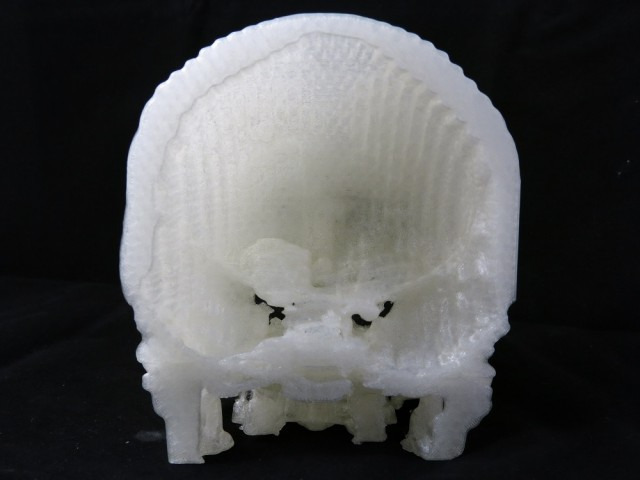How a man used 3D printing to help treat his wife’s brain tumor

In the summer of 2013, Pamela Shavaun Scott started having “24/7 severe headaches” — so severe that she couldn’t sleep. It wasn’t before December that she heard for sure that it was a brain tumor.
Initially, when Scott had an MRI, radiologists seemed unconcerned when they discovered a mass over an inch in diameter. About three months later, after another MRI, doctors said that it had ballooned about half a centimeter, a sign of malignance. Scott’s husband, Michael Balzer, requested her DICOM files, which are commonly used for medical imaging.
As first detailed by Make magazine, Balzer, who is a 3D imaging expert behind the website AllThings3D, used Photoshop and layered the 2D images to compare what radiologists were telling his wife to his own research. He found the tumor hadn’t grown at all. It was clear they couldn’t simply rely on what the doctors were saying.

Image: Michael Balzer
This image shows that two radiologists from the same clinic came up with two different measurements, despite the tumor not growing at all, Balzer said.
Scott, who is a family psychotherapist that researches things like video game addiction, said several neurosurgeons told her that, because of the mass’ location (behind her left eye), the only option was “sawing your skull open” and lifting the brain to remove the tumor, which, of course, comes with tons of risks, including possible cognitive damage and blindness. Scott worried she’d never be the same.
It was the second time doctors were telling the couple about frightening possible scenarios; Scott had her thyroid removed in 2013, an altogether separate medical ordeal. Some doctors predicted similarly invasive procedures for that, but through diligence, she was able to undergo a comparatively minor procedure at the University of Pittsburgh Medical Center.
Balzer began experimenting with 3D imaging technology from other parts of the world. Using a tool called InVesalius — open-source software from Brazil that uses DICOM, MRI and CT files to visualize medical images — as well as another imaging software 3D Slicer, he was able to create renderings of his wife’s tumor. The couple sent them out to hospitals across the country around February, Balzer said.
UPMC — the same hospital where Scott had here thyroid removed — agreed to take on the operation. The procedure, compared to the other options, was almost completely harmless. Instead of sawing into her skull and lifting the brain, the doctors planned to go through her eyelid.
The couple sent the hospital the DICOM files, as well the 3D volume renderings. And about three weeks prior to when the couple arrived in Pittsburgh for Scott’s surgery, Balzer sent the surgeons a physical 3D rendering of parts of his wife’s skull so they could examine and look at what they were dealing with. He said it was the first time doctors had something like that.

Image: Michael Balzer

Image: Michael Balzer
The surgeons were able to remove 95% of the tumor (about 5% was wrapped around the optical nerve — too dangerous to remove). There’s a very slim chance that it will grow back, the couple said. After the surgery, Scott said it took her fewer than three weeks to recover enough to return to work.
Though Balzer’s 3D renderings can’t take all the credit for how smoothly everything went, he said that the surgeons were “very excited” about what he had done. He also realized that he didn’t need to rely on doctors alone for medical advice.
“There’s a lot of open-source stuff out there,” Balzer said. “The Internet is a very powerful tool now. People shouldn’t just rely on their doctor’s recommendations.”
BONUS: What is 3D printing, and how does it work?
Have something to add to this story? Share it in the comments.
